The Grindel Filmtheater
|
Read more
at in70mm.com The 70mm Newsletter |
| Written by: Gerhard Witte, Berlin | Date: 26.07.2009 |
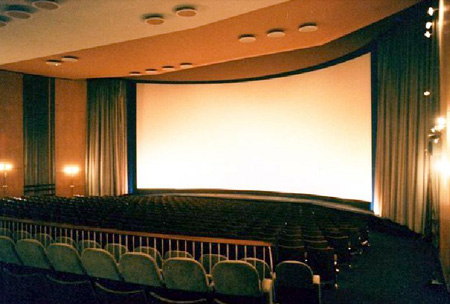 Grindel Filmtheater in all its curved screen glory of the 1960s. Image from Gerhard Witte's collection Grindel Filmtheater in all its curved screen glory of the 1960s. Image from Gerhard Witte's collectionThe Grindel Filmtheater in Hamburg, Grindelberg 7a, opened on the 25.11.1959 with the film “Im Zeichen Roms/Nel Segno di Roma/Sign of Rome/Sign of the Gladiator” in Eastmancolor and Dyaliscope with Anita Ekberg. |
More
in 70mm reading: Das Grindel Filmtheater DP70s in Germany Internet link: Save the Grindel |
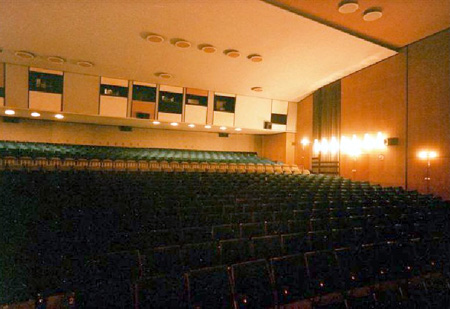 Grindel Filmtheater of the 1960s. Image from Gerhard Witte's collection Grindel Filmtheater of the 1960s. Image from Gerhard Witte's collectionThe architect was the renowned Joachim Glüer (also in collaboration with Gerd W. Blaettchen at that time), who earlier designed the first TODD-AO Filmtheater in Europe, the “Savoy” - also in Hamburg, which opened on the 14.03.1957 with the film “The Brave One”, later on followed by “Oklahoma!” in TODD-AO. The screen size of this theater was 20 x 8,4 m. From August 2008 until end of October 2011 the Savoy was the temporary home of the Metropolis cinema which belongs to Hamburg`s Kinemathek e.V. Then the movie theatre was closed and has an uncertain future now. The Grindel Filmtheater had 753 seats and it was reported, that on the 13.11.1960 already 77 777 cineastes had attended the cinema. |
Memories When I was a little boy, I saw nearly every film in this wonderful cinema. Great experiences which I remember to this day. Many greetings from Berlin Gerhard Witte Berlin, 24.07.2009 |
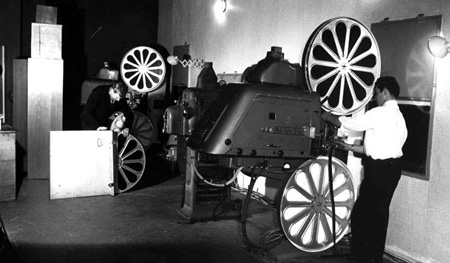 Grindel Filmtheater and the Cinerama projectors. Image from Gerhard Witte's collection Grindel Filmtheater and the Cinerama projectors. Image from Gerhard Witte's collectionIn January 1963 the cinema was closed for some modification. It again was opened on the first February 1963 with the German premiere of the film “How the West Was Won” in Cinerama with a new huge curved louvered screen with the size of 27 x 10 m. The Grindel Filmtheater now was called “Cinerama Grindel Filmtheater”. Later, 6 projectors in the projection room were able to show all film formats, also Sensurround. At that time, below the cinema, there existed a restaurant with the name "Nürnberger Bratwurstglöckl". When there were shown Sensurround films "aloft" sometimes it happened, that through the vibration of the cinema, plaster from the ceiling of the restaurant directly fell into the food of the guests. It gave troubles with the owner of the restaurant. |
|
70mm Premiere |
|
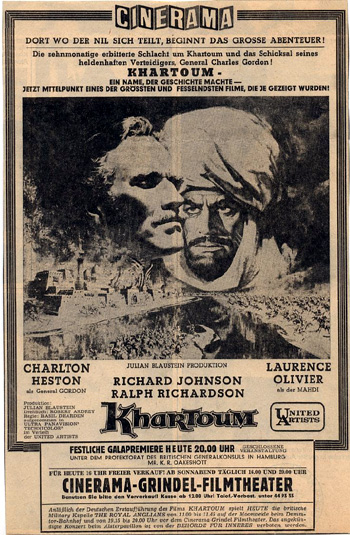 Khartoum
(UK, 1966) - Premiere film advert from the Grindel premiere on 22 September
1966. All adverts in this report are from Gerhard Witte's collection. Khartoum
(UK, 1966) - Premiere film advert from the Grindel premiere on 22 September
1966. All adverts in this report are from Gerhard Witte's collection.A lot of North-German film premieres took place at this cinema For example: ”The Wonderful World of the Brothers Grimm” “It's a Mad Mad Mad Mad World” “Cheyenne Autumn” “The unsinkable Molly Brown” “Ryan's Daughter” “The Greatest Story ever Told” and of course “Doctor Zhivago”. At that time, believe it or not, the film successfully ran for 134 weeks. There also was the world premiere of the film “Genghis Khan” in 70mm (blow up) with the presence of the main-actors in April 1965. |
|
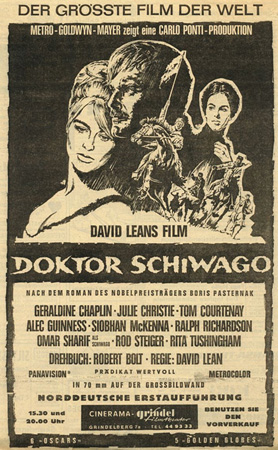 Doctor
Zhivago: (USA/Italy, 1965) - The film had its premiere on 18 November 1966.
"The revolution simply provides the canvas against which is told a moving
and highly personal love story". (David Lean) Doctor
Zhivago: (USA/Italy, 1965) - The film had its premiere on 18 November 1966.
"The revolution simply provides the canvas against which is told a moving
and highly personal love story". (David Lean) |
|
New Owners, New name |
|
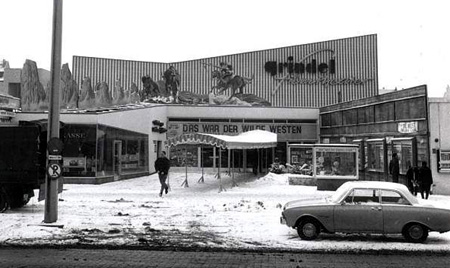 Grindel Filmtheater exterior on a winter day with snow. Image from Gerhard Witte's collection Grindel Filmtheater exterior on a winter day with snow. Image from Gerhard Witte's collectionAt the start of its life, the Grindel movie theatre was a free-standing and easily visible building, standing some metres alongside the street called Grindelberg. During 1970/71 an office building was placed "under the nose" of the cinema. Sadly, this means the movie palace was no longer visible. It was then only possible to get into the entry area (foyer) by walking through the ground floor of the office building in front of it. In 1975 the “Universum Film AG” called “UFA” became owner of the cinema. The new name now was “UFA Grindel Filmtheater”. Mr. Heinz Riech, the now on principal of a lot of cinemas in Germany, minimised the foyer in order to build here another 2 “Carton-Cinemas”. The generous charm of the cinema's foyer was lost. The main cinema remained untouched and in 1989 the THX-Sound-System was installed here. |
|
More screens |
|
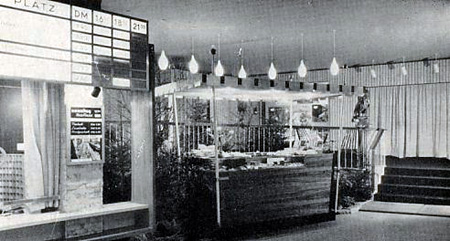 Grindel Filmtheater's original foyer. Image from Gerhard Witte's collection Grindel Filmtheater's original foyer. Image from Gerhard Witte's collectionIn the middle of 1995 another alteration took place. The 2 little foyer cinemas were disposed. Already in advance the large curved screen (27 x 10 m) in the main (old) cinema was replaced by a flat, less large screen (20 x 11 m). Also the interior outlook of the cinema has been changed. |
|
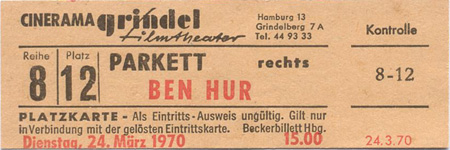 Another 5 cinemas were attached on the front site of the old cinema: Another 5 cinemas were attached on the front site of the old cinema:Cinema 1: 653 Seats (Main Cinema) Dolby Digital, DTS, SDDS, THX, 70mm Screen Size: 20 x 11 m Cinema 2: 205 Seats Dolby Digital Screen Size: 13 x 8 m Cinema 3: 227 Seats Dolby Digital Screen Size: 13 x 8 m Cinema 4: 283 Seats Dolby Digital, DTS Screen Size 13 x 8 m Cinema 5: 257 Seats Dolby Digital Screen Size: 10 x 7 m Cinema 6: 285 Seats Dolby Digital, DTS Screen Size: 13,5x8 m |
|
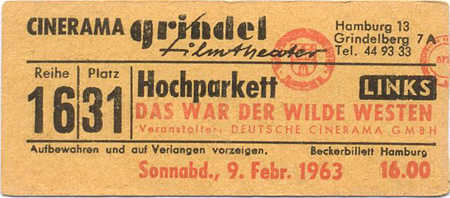 On the 24.11.1995 the first Hamburger Multiplex Cinema, now named the “UFA Grindel Palast”, opened with 1910 seats on the whole again. On the 24.11.1995 the first Hamburger Multiplex Cinema, now named the “UFA Grindel Palast”, opened with 1910 seats on the whole again.After closure of the Hamburger "City Filmtheater" in 2001, original English film versions and the popular "Sneak Previews" went to the UFA Grindel Palast and in 2007 the 3-D-Digital-Film found its way into the cinema too. This was the last attempt to avoid the lack of visitors – but, last not least, unfortunately unfruitful. The rent was put up and the existence of the cinema came in danger. |
|
Save The Grindel - The Lost Battle |
|
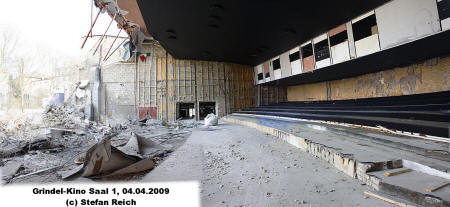 A dramatic image of Grindel Filmtheater's demolition in April 2009. Image by Stefan Reich A dramatic image of Grindel Filmtheater's demolition in April 2009. Image by Stefan ReichAn association with the name “Save the Grindel” was founded. In spite of a large collection of signatures and intensive contact to the politicians the result was without a success.. Nearly after 50 years of existence, on the 26.03.2008, the cinema was closed in order to clean a space for residential property. R.I.P. |
|
 The
Alamo (USA, 1960) - John Wayne`s epic western premiered in Todd-AO on 16
February 1961. The mission that became a fortress... The fortress that
became a shrine. The
Alamo (USA, 1960) - John Wayne`s epic western premiered in Todd-AO on 16
February 1961. The mission that became a fortress... The fortress that
became a shrine. |
|
 South
Pacific (USA, 1958) - on 10 September 1964 for the first time in Todd-AO on
Grindel`s deeply curved 27x10 metres screen. Rogers and Hammerstein got
their stirring stage show in brilliant colours and with 6-channel magnetic
sound also in cinemas. South
Pacific (USA, 1958) - on 10 September 1964 for the first time in Todd-AO on
Grindel`s deeply curved 27x10 metres screen. Rogers and Hammerstein got
their stirring stage show in brilliant colours and with 6-channel magnetic
sound also in cinemas. |
|
 Gone
With the Wind (USA, 1939) - premiered at the Cinerama Grindel Filmtheater in
a 70mm version on 02 October 1969. The film burst upon the movie world in
1939 amid the claims that it was the greatest motion picture ever made. Gone
With the Wind (USA, 1939) - premiered at the Cinerama Grindel Filmtheater in
a 70mm version on 02 October 1969. The film burst upon the movie world in
1939 amid the claims that it was the greatest motion picture ever made. |
|
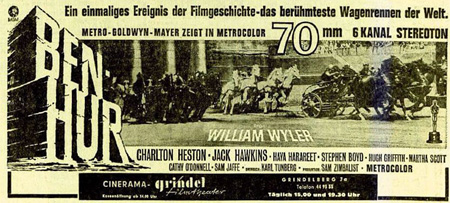 Ben
Hur (USA, 1959) - previously William Wyler´s magnum opus was continuously
shown for more than two years at the Hamburger Savoy cinema. Now at the
Grindel from 30 January 1970 for 8 weeks on the large screen. Ben
Hur (USA, 1959) - previously William Wyler´s magnum opus was continuously
shown for more than two years at the Hamburger Savoy cinema. Now at the
Grindel from 30 January 1970 for 8 weeks on the large screen. |
|
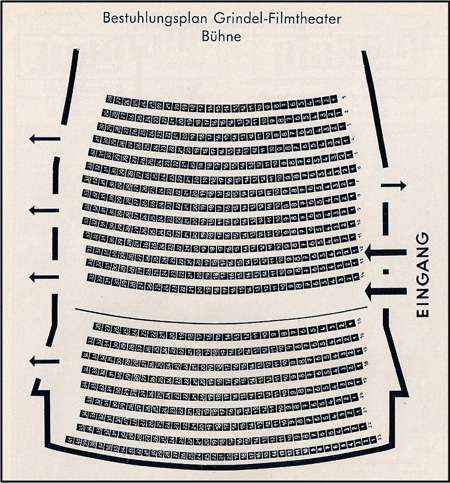 Seating
plan. Picture taken from the brochure “Filmtheater in der Freien und
Hansestadt Hamburg”. Seating
plan. Picture taken from the brochure “Filmtheater in der Freien und
Hansestadt Hamburg”.When the movie theatre opened in 1959, its 753 seats were covered with orange and blue-green dralon. The walls of the auditorium were panelled with alpine ash and wood from Makassar, decorated with Putzler lamps.The floor was laid with green-black Girnowa carpet. In the foyer, the walls were clad with stained maple wood. The movie theatre was built by the real estate company Hamburger Haus mbH. (Source: Filmjournal "Hamburger Flimmern") |
|
 The
UFA Grindel Palast in Grindelberg Street (here main entrance) closed forever
in March 2008. The former cinema foyer was preserved and now houses a chemist´s shop. Picture taken by the author. The
UFA Grindel Palast in Grindelberg Street (here main entrance) closed forever
in March 2008. The former cinema foyer was preserved and now houses a chemist´s shop. Picture taken by the author. |
|
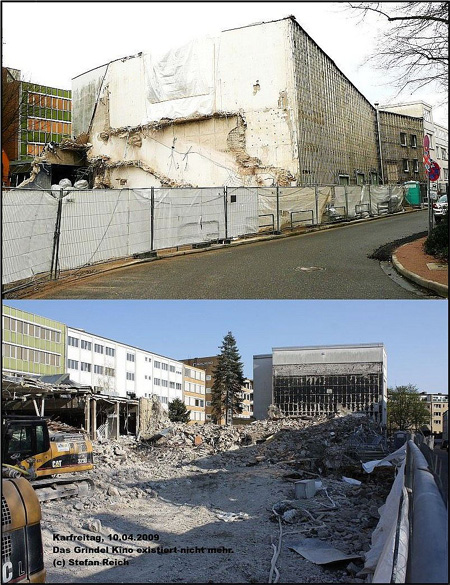 The
former Cinerama cinema was demolished in the end. Picture taken by Stefan
Reich. The
former Cinerama cinema was demolished in the end. Picture taken by Stefan
Reich. In April 2009, the demolition ball put an end to the Grindel movie theatre. After almost half a century, the cinema halls had now finished their service and the more lucrative rental apartments were built in their place. Seats, screens and projectors moved to Serbia (Belgrade). The director Emir Kusturica, he became famous for his films “Arizona Dream” (USA/France, 1993) and “Life is a Miracle” (Serbia/Montenegro/France/Italy, 2004), found use for all in order to realize a new cinema project. |
|
 Information
of the Hamburg Film and Television Museum can be found at: Information
of the Hamburg Film and Television Museum can be found at:www.filmmuseum-hamburg.de |
|
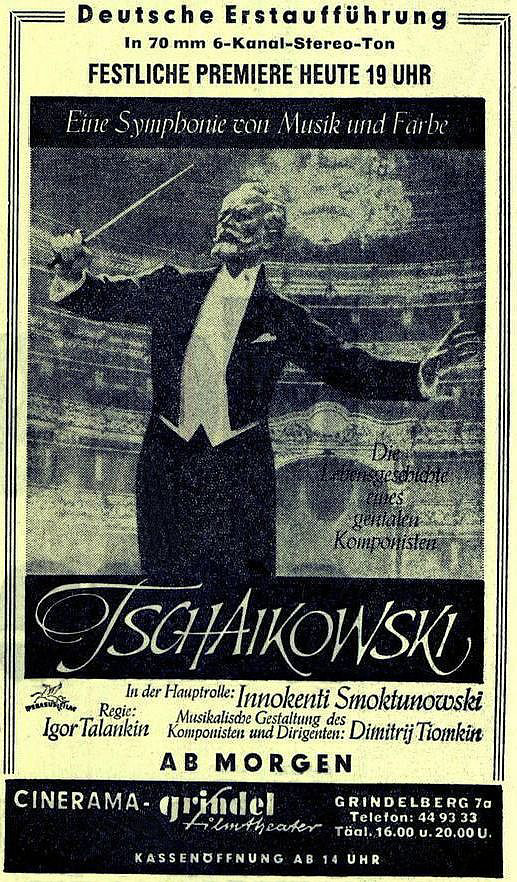 "Tschaikowski"
festive premiere at Hamburg´s Grindel-Filmtheater "Tschaikowski"
festive premiere at Hamburg´s Grindel-Filmtheateron Friday, September 17, 1971 (in 70mm and 6-channel magnetic sound) |
|
|
Go: back
- top - back issues
- news index Updated 22-01-25 |
|
